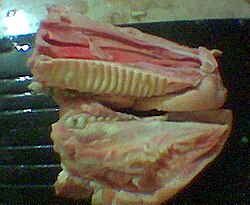|
Secondary palate
The secondary palate is an anatomical structure that divides the nasal cavity from the oral cavity in many vertebrates. In human embryology, it refers to that portion of the hard palate that is formed by the growth of the two palatine shelves medially and their mutual fusion in the midline. It forms the majority of the adult palate and meets the primary palate at the incisive foramen. Clinical significanceSecondary palate development begins in the sixth week of pregnancy and can lead to cleft palate when development goes awry. There are three major mechanisms known to cause this failure:
EvolutionThe secondary palate is thought to have a significant role in the development of some warm-blooded animals. The separation of the mouth from the nasal cavity also allowed chewing and breathing to occur at the same time. Early creatures with secondary palates include crocodilians (who are cold-blooded), and cynodonts and a few others among the therapsids, known from the fossil record in the mid-Permian. Mammals inherited our hard palates from the cynodonts. References
|
||||||||||||||
